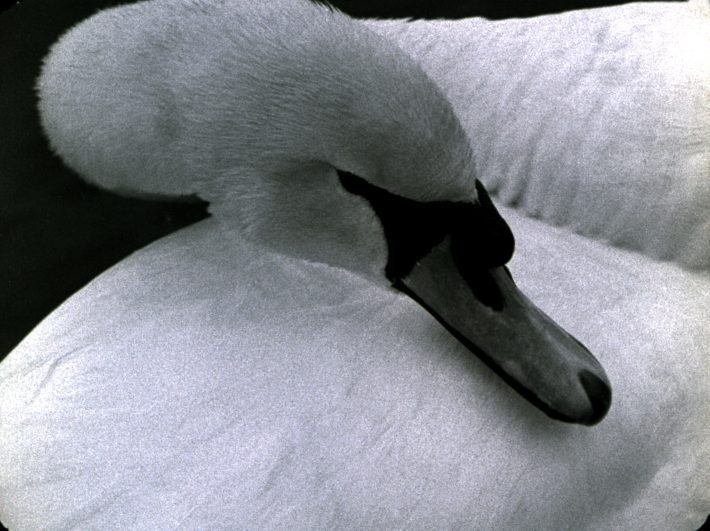In Focus: Alia Syed
Her work investigates the nature and role of language in intercultural communication, with a focus on borders and boundaries, translation and the trans-cultured self. Syed’s films draw from personal and historical realities in order to address the subjective relationship to gender, location, diaspora and colonialism.
Born in 1964 in Swansea, Alia Syed grew up in Glasgow and now lives in London. Her films have been shown at international institutions such as LACMA, the Moscow Biennale, Museo Nacional Centro de Arte Reina Sofía, Hayward Gallery, Tate Modern, Tate Britain, INIVA, WKV Stuttgart and the Yale Centre for British Art. This retrospective is the first comprehensive survey of her work in the UK. It provides an overview of four decades of moving image practice, from early student films such as Swan (Syed’s degree piece at the University of East London) and Fatima’s Letter (made whilst at the Slade) to the festival premiere of her recent video work Snow (2019). The retrospective is accompanied by an exhibition at Mimosa House of Syed’s Meta Incognita
Alia Syed 1
Thu 9th September, 20.45 | ICA
Alia Syed 2
Sun 12th September, 18.00 | Genesis Cinema
Alia Syed 3
Mon 13th September, 18.15 | Genesis Cinema
Alia Syed, Meta Incognita
Wed 1st – Sat 11th September, 12pm-6pm (except Sun 5th Sept) | Mimosa House

Swan by Alia Syed. Courtesy the artist and LUX, London
Twirling
by Rebecca Jane Arthur
“As things have become loud again,
we have taken up twirling – it makes us light.”
Watching Alia Syed’s films, spun over four decades from the mid-80s till today, motifs appear and reappear, haunting the screen. Images and sounds layer and double before me. Literary references intertwine – poetry, allegories, myths, rhymes, song. Directions are sounded by a familiar accent, reminding me of home: “She turns, looks to camera. Cut.” Syed’s Glaswegian lilt warms her material: sculpting and welding together many of her pieces. The voice, her voice or a voice, whispers, confides, insists, and plays in a language known to me and in another unknown – tongues, layered, lapping – one over the other. Translations and intertitles wave in and out of sync with sound. Repetition and onomatopoeia draw me inwards to meet the characters of her dialogues – “tuck, tuck: children playing.” Even the silent films speak.
While I know Syed’s work to be alive with sound, even original compositions, I am drawn to two of her surviving student films, both silent. I’m seized by the insights they provide into her filmic beginnings, her visual language. The muted, black-and-white creature in Swan (1987), one of her first films, is captured bracing for flight, writhing and amplifying its force with the strokes of its wings, like winding up a Bolex ready to shoot. Its plumage is tangible. In contrast to the swan’s serene, object-like beauty, Syed films the energy underlying the animal, capturing its prowess and sensuality, its elegance and power. The images repeat, loop, and enchant. In Durga (1985), I watch the rise and fall of an impregnated belly, the home of the womb. In silent observation, the breath is heard through the light that echoes outwards from the dark concave hollow of the navel. A hand casts a white sheet into the air. It tumbles, floats, and tumbles again, downwards, in the middle of a spiral staircase. Folding in on itself, unfolding, unravelling, falling. Tumbling. Turning. Twisting. Twirling. And repeat. The textile is tactile. It’s translucent, captured on black-and-white filmstock. Shadows appear. Images overlap. Until the film’s black becomes white – exposed.
Turning backwards, I uncover that Syed’s first-ever student works are lost. Still, until found. Looking forwards, the imagery, symbolism, and hypnotic rhythms in montage from her early works return to me in the films that ensued through gestures, movements, structures, surprises, counterpoints. Each film is unique in subject and sound, but part of a thread: the red thread that weaves in and out of one’s life, tying it all – heritage, language, culture, politics, faith, pain, pleasure, creation, stagnation, reflection, success, failure, love, loss – together. An elaborate weave of multiple strands of identity, memory, and meaning. Attention is in the detail. Syed’s films aren’t just beautiful; they destabilise you, sending you into a spin. Often, she captures landscapes and cityscapes that fold in on you, making you feel small: a busy marketplace, train station, or road junction – each with their own set of rules. One has the sensation, time and again, that one must beware of being folded away, beware of constrictions. And when things become too loud, heavy, or oppressive, a narrator in Eating Grass (2003) shares the key to regaining a sense of autonomy: take up twirling, as “it makes us light.”
